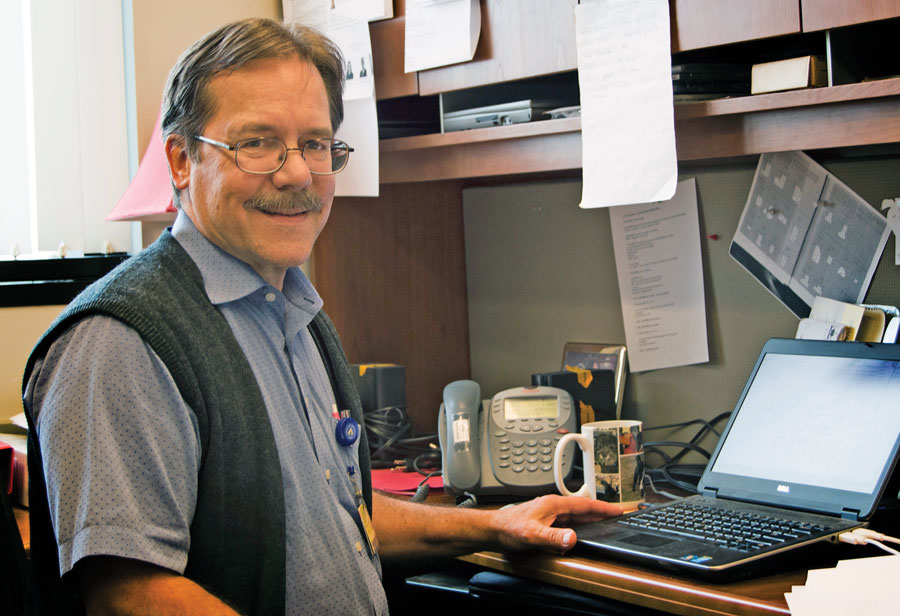Whether listening to music, deciphering speech, or hearing the wail of an emergency siren, sound is fundamental to how we experience and respond to the world around us. Our perception of sound is key to communicating with others, can warn us of danger, and is capable of evoking great emotion, playing a vital role in our social, mental and emotional lives.
How sound reaches the brain
In order for the brain to make sense of the sensory input, it has to receive information in a currency it understands – electrical signals. Sound waves are converted into electrical signals in the inner ear through a finely choreographed sequence of activity. After activating the eardrum, sound waves stimulate the movement of tiny cells in the inner ear known as hair cells. Hair cells – so-called due to the hair-like bundles that sit atop them – are then moved by motion in the fluid of the inner ear, which changes the electrical properties of the cells. This means that information can be sent to the brain in the form of electricity via nerve cells.

Professor Fuchs and colleagues have shown that efferent innervation of inner ear cells changes over time and could be significant to the hearing loss that many people experience in later life ![]()
Afferent signals: ear to brain
Two classes of afferent neurons innervate the cochlea, referred to as Type I and Type II spiral ganglion neurons. These cells carry information towards the brain. Larger Type I afferents report information about sound including timing, intensity, and frequency with each one having a single dendrite – a spiny branch that carries information to the neuron cell body – that connects to a hair cell. Working together, Type I cells relay the information content of sound up to our brains to be processed.
Type II neurons are less prevalent and much smaller in size, making them altogether more elusive and difficult for scientists to study.
Although their existence had been known for 60 years, the function of these rare little cells remained a puzzle until 2009 when a graduate student in Paul Fuchs’ laboratory, Catherine Weisz, identified the function of Type II cells, making a major breakthrough in auditory science. First published in Nature, the team accessed the neurons by dissecting the cochlea from young rats. By using specialist electrophysiological equipment to measure electric currents, Weisz was able to show that Type II neurons did react to sound, but in a rather surprising way.
Cells for painful sounds
Intriguingly, the study showed that the neurons were sensitive to a chemical known as ATP, a molecule linked to pain and to tissue damage. The cells were already known to react only to very loud sounds. This led Chang Liu in the Fuchs group to show that Type II cells are strongly activated when cochlear hair cells are damaged, as can occur during extreme noises – sounds which could be described as painful, or even traumatic. Many of us have experienced sounds that made us uncomfortable and could even be described as painful, leading us to remove ourselves from that situation and it is possible that Type II neurons are fundamental to initiating this behavioural response. Professor Fuchs hopes to develop an animal model to explore behaviours related to acoustic pain processing.
Whilst it may be intuitive that the brain receives signals from ear cells, cells in the ear also receive outgoing signals from the brain. Professor Fuchs and colleagues have characterised the function and molecular make up of efferent neurons, including medial olivocochlear neurons (MOC). It is known that MOC neurons play a role in governing the sensitivity of afferent signalling, reliant on unusual nicotinic acetylcholine receptors, which could be a route of investigation for future drug studies.
Type II cells may be responsible for processing extreme noises – sounds which could be described as painful, or even traumatic ![]()
Looking to the future
Whilst much is yet to be discovered about how we process auditory stimuli, great strides have been made in understanding the function of cochlear cells that are at the centre of our ability to hear. Professor Fuchs’ continued commitment to characterising the make-up of cochlear neurons may provide key insights into therapeutics for hearing disorders such as hyperacusis and tinnitus. In the meantime, the next time we hear a piercing alarm, we might want to thank our Type II neurons for the warning.
Since my biology thesis at Reed College with Stephen Arch, I have been interested in synaptic signalling. My doctoral thesis at Stanford with Donald Kennedy concerned presynaptic inhibition at the crayfish neuromuscular junction. As a postdoctoral fellow with Robert Fettiplace at Cambridge University, I learned that the inner ear (in that case, of the turtle!) provides an outstanding model for linking synaptic signalling directly to perception and behaviour. The solitary synaptic contact of each Type I cochlear afferent confers its frequency selectivity, timing and intensity coding. Inhibitory synapses from a unique class of efferent cholinergic neurons regulate cochlear sensitivity. So one can assign fundamental aspects of hearing to the function of these synaptic contacts.
Are some people more sensitive to noise than others, and could this be mediated via Type II cells?
Yes. Hearing loss often is accompanied by a paradoxical ‘gain of function’ pathology, hyperacusis, whose most severe manifestation results in pain on exposure to only moderately loud sound. Such morbid hyperacusis (‘noxacusis’) may be a product of upregulated Type II afferent sensitivity, analogous to the hyperalgesia that contributes to neuropathic pain in the somatic nervous system.
What do you hope will be the next big breakthrough for hearing basic research?
Our own work is aimed at drug targets that could ameliorate or prevent acoustic trauma and associated pathologies such as hyperacusis and tinnitus. Positive modulators of inhibitory synapses could protect from acoustic trauma. Drugs that silence Type II neurons after damage is done could reduce hyperacusis. Longer term is the hope to regenerate cochlear hair cells whose loss underlies profound deafness, perhaps through the use of stem cells. Nearer-term is the possibility of using gene therapy to restore synaptic connections of afferent neurons that retract after acoustic overexposure, or as a function of age. Finally, cochlear implants, other hearing prosthetics and their implementation will continue to improve, providing tremendous benefits today.
What are the best ways to protect our ears from damage?
Avoid prolonged exposure to very loud sound (gunfire, many workplaces, many music venues). The challenge is that such damage may be imperceptible at first but accumulates over time and can hasten or exacerbate age-related hearing loss.
Does the cochlea have the ability to repair itself after damage?
In short, no. At least, we mammals have lost the capacity to regenerate hair cells that is found in all other vertebrates. The partial denervation of the cochlea also appears to be irreversible. There can be temporary threshold shifts after acoustic overexposure that recover in days. However, this is a warning sign to avoid repetition of that experience – the underlying damage can accumulate and become permanent.
The best ways to protect our ears from damage? Avoid prolonged exposure to very loud sound (gunfire, many workplaces, many music venues) ![]()
Professor Fuchs investigates the detailed workings of the inner ear.
Funding
- NIH
- The David M. Rubenstein Fund for Hearing Research
- The John E. Bordley Professorship
Collaborators
- Dr Elisabeth Glowatzki, Professor of Otolaryngology-Head and Neck Surgery, JHU School of Medicine
- Dr Hakim Hiel, Senior Research Associate, Otolaryngology-Head and Neck Surgery, JHU School of Medicine
- Dr Ana Belen Elgoyhen, Professor of Pharmacology in the Faculty of Medicine of the University of Buenos Aires
- Dr Eleonora Katz, Associate Professor, Department of Physiology, Molecular and Cellular Biology, Faculty of Exact and Natural Sciences, University of Buenos Aires
- Dr Rai Winslow, Raj and Neera Singh Professor of Biomedical Engineering, JHU School of Medicine
Bio
 Paul Fuchs is a graduate of Reed College (biology, 1974) and Stanford University (PhD neurobiology 1979). After postdoctoral work at Cambridge, he joined the Physiology faculty at the University of Colorado in 1983. He moved to Johns Hopkins in 1995 where he is the John E. Bordley Professor and vice-Chair for Research in Otolaryngology-Head and Neck Surgery.
Paul Fuchs is a graduate of Reed College (biology, 1974) and Stanford University (PhD neurobiology 1979). After postdoctoral work at Cambridge, he joined the Physiology faculty at the University of Colorado in 1983. He moved to Johns Hopkins in 1995 where he is the John E. Bordley Professor and vice-Chair for Research in Otolaryngology-Head and Neck Surgery.
Contact
Professor Paul Fuchs
Johns Hopkins University
School of Medicine
Department of Otolaryngology,
Head and Neck Surgery
Baltimore, MD 21205, USA
E: pfuchs1@jhmi.edu
T: +1 410 955 6311
W: www.hopkinsmedicine.org/profiles/results/directory/profile/3376185/paul-fuchs
W: http://neuroscience.jhu.edu/research/faculty/30
W: http://centerforsensorybiology.org/fuchs-laboratory/









